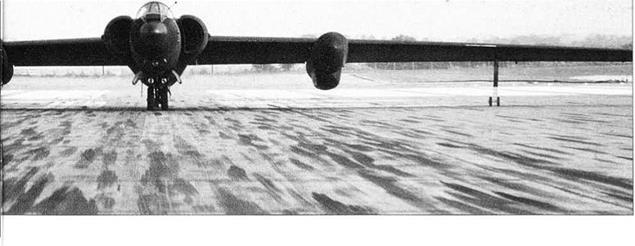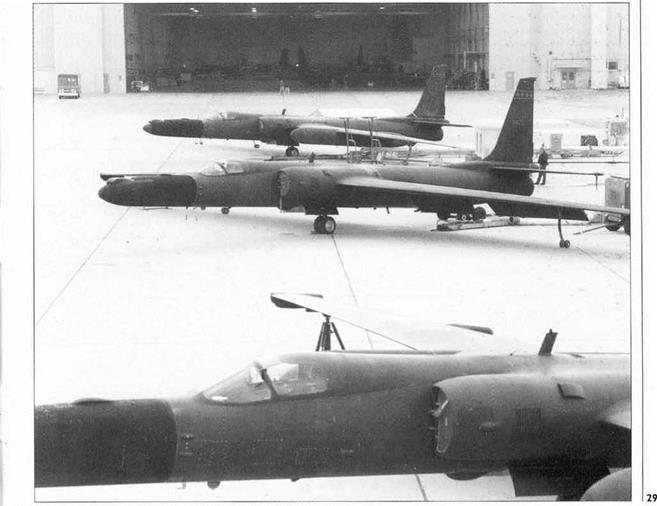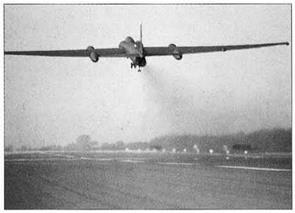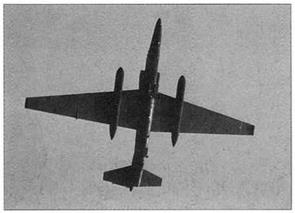Air Force Operations
With the Agency U-2 operation up and running, the Air Force began recruiting pilots for its program largely from the same source; namely, the two recently deactivated SAC F-84 wings at Turner AFB, Georgia. Having undertaken ground crew and pilot training at Area 51, Col Jack Nole, commander of the 4028 Strategic Reconnaissance Squadron (SRS), led the first of two three-ship U-2 formations down to their new home at Laughlin AFB, Texas on 11 June 1957. Part of the 4080 SRW, their
sister squadron, the 4025th SRS, were equipped with Martin RB-57Ds. Seventeen days later disaster struck. Shortly before 9am on Friday 28 June, Lt Ford Lowcock crashed his U-2 near Del Rio, a few miles from Laughlin, and was killed, just three days after his first U-2 flight. Then, three hours later, Lt Leo Smith crashed his U-2 about thirty miles north of Abilene, Texas. He too was killed. Accident investigations determined that fuel imbalance in the wing tanks was probably a contributory factor in both incidents.
During September, the 4028th received five more U-2s which were assigned to the Air Force project HASP (High Altitude Sampling Program), sponsored by the Defence Atomic Support Agency (DASA). The objective was to determine the role played by the stratosphere in the worldwide distribution of fusion products resulting from nuclear explosions. In all the program lasted five years and involved some 45,000 flying hours – almost all in U-2s. Eventually DASA published its results, making its findings available to the UN. The result was a ban on all ‘air burst’ testing of nuclear weapons.
|
|
![]()

During July and August 1962, John McCone, Director of the ‘Agency’ (he replaced Allen Dulles after the CIA – sponsored ‘Bay of Pigs’ affair), received a number of increasingly disturbing accounts concerning a Soviet military build-up on the island of Cuba. On 22 August he went directly to President Kennedy stating that it was his belief that Cuba were receiving intermediate range
Be/ow left During the‘bad old days’ of the Cold War, Alconbury based aircraft would usually take up station over Germany, reaching 60,000ft about 30 miles south of Amsterdam, whereupon they would turn off their mode ‘Charlie’ height read-out.
(Paul Crickmore) .
Be/ow The 95RS used ROOK as its call sign for all training sorties. Here Maj Blaire Bachus, flying ‘093, Rook 32, climbs away after another touch and go. (Paul Crickmore)
|
|
ballistic missiles. The President demanded corroborative evidence of such aggression before taking further action. Consequently, CIA U-2 overflights of the island were stepped up, with flights on the 28th August, 5, 17, 26 and 29 September and the 5 and 7 October. However, only evidence of SAM construction sites and increased fighter activity including the delivery of MiG-2 Is was detected. It was an alert photo-interpreter in the Defence Intelligence Agency (DIA), who noticed that the layout of some of these SA-2 sites on Cuba matched those deployed to protect offensive ballistic missile sites in the Soviet Union. When the Committee on Overhead Reconnaissance (COMOR) reconvened on 4 October, further coverage of western Cuba was requested. Despite the risks, again it was decided to use the U-2. However, as a potential military conflict seemed to be brewing on the island, the Air Force, with support from the Secretary of Defence, Robert McNamara, insisted that it should fly all future U-2 sorties over Cuba. A view which, after some squabbling, was upheld, and on Wednesday 10 October the President sanctioned a resumption on U-2 flights over western Cuba.
It had been agreed that Agency U-2Cs would be used by the Air Force, as these were equipped with both System 9 and System 12 ECM units – the latter was a Radar Homing and Warning Receiver (RHAW), which warned the pilot if he was being tracked by SAM radars.
Majors Anderson and Heyser were chosen to conduct the flights as they had both checked out in the ‘C’ model, so they were packed off to Edwards North Base to join up with their mounts. Early on the morning of 14 October, Steve Heyser took off from Edwards and headed towards Isla de Pinos and then north toward the Cuban mainland. The most critical portion of the mission was the run from San Cristobal, which lasted approximately five minutes, after which Heyser set course for McCoy AFB, Florida – from where it had been agreed, future sorties over the island would be based. Upon landing, the
film was rushed to the National Photographic Interpretation Centre (NP1C), at Washington via a waiting Air Force jet. At about 5.30 on the afternoon of the 15th, Arthur Lundahl, the head of NPIC, passed the news to CIA headquarters – now located in Langley, Virginia – that Heysev’s film had captured the required evidence. Khrushchev was in the process of deploying SS-4 MRBM’s (NATO codename Scandal), right in America’s back yard. Shortly before 9am on Tuesday the 16th, McGeorge Bundy, Kennedy’s assistant for National Security Affairs, showed his president the photos. For the next thirteen days, Kennedy and a circle of his closest advisors became embroiled in a crisis that took the world to the brink of a nuclear holocaust.
Early on the morning of 15 October, Randy Anderson had launched from Edwards and conducted a sortie similar to that of Heyser, but it was appreciated that two U-2Cs would not be nearly enough resource for the job in hand. With its U-2s participating in the HASP and therefore stationed all around the globe, the 4028th SRS faced the challenge of gathering together enough aircraft to provide national command authorities with the vast amount of timely imagery upon which crucial decisions would be based. However, with extraordinary effort, the Air Force managed to muster ten aircraft and eleven pilots. At 4am on Tuesday 16th, three U-2 As were launched in blinding rain from Laughlin to conduct further overflights – like the preceding U-2Cs, they also recovered into McCoy.
As analysis of U-2 imagery continued, NPIC were able to confirm two MRBM sites near San Cristobal, each equipped with a regiment of eight SS-4s on launches with eight more ready for a second salvo, and that both sites were operational. Another regiment of SS-4s was discovered near Sagua La Grande; they were expected to become operational within a week. Finally the interpreters were convinced that they had also found two sites, near Guanajav, that were intended for the 2,200 mile-range
Top and above The original plans for the 17RW involved basing 12 aircraft at Alconbury and six at Weathersfield, two TR-ls were then to orbit over Central Europe 24 hours a day. In the event, Alconbury never operated more than eleven aircraft before the Cold War melted away. (Paul Crickmore Collection)
Right Returning from the Gulf War, these six U-2Rs were dispatched to Plant 2 at Palmdale, where Lockheed Martin provides support. (Lockheed Martin)
SS-5s (Skean), which, they predicted, would be operational in six to eight weeks – these missiles touted a range capability that threatened US ICBM bases in the north of the country. On top of all this, 4028th surveillance also discovered crates containing Ilyushin 11-28 bombers at San Julian airfield and thirty nine MiG-2 Is at Santa Clara.
In the cabinet room at 9.45 on Friday 19th October, Kennedy met with his joint Chiefs of Staff. The ever bullish Air Force Chief of Staff, Gen Curtis Le May, was in no doubt what should be done, … “ take out the missiles, I think you’ve got to take out their air with it, and their radar, communication, the whole works. It just doesn’t make any sense to do anything but that.”
Luckily for humanity, the result of a long-running meeting at the State Department on Saturday formed the basis of a more rational policy, which was accepted by Kennedy on Monday; namely, that the island would be blockaded and the United States would pledge to Khrushchev the withdrawal of US Jupiter IRBMs in Turkey, in exchange for a quid pro quo withdrawal of Soviet missiles in Cuba.
That same day, following further meetings with the JCS and briefings to Senior Democrat and Republican
leaders of Congress, Kennedy delivered a televised address to tens of millions of anxious viewers across the United States, the speech was then re-broadcast and distributed in many languages around the world.
Now the crisis was in the public domain, low-level photo recce sorties by Air Force RF-101 Voodoos and US Navy RF-8 Crusaders were also authorised. On Wednesday 24th October, the first signs that sense was beginning to prevail emerged when Soviet freighters, en route to Cuba, were seen to heave to in mid Atlantic.
Three day’s later, Randy Anderson got airborne from McCoy in Article 343 for another overflight. Flying along the northern coast of Cuba, despite carrying the System 12 SAM radar warning receiver, he was taken by surprise by a salvo of SA-2s fired from Banes naval base, at the eastern end of the island. One missile exploded above and behind the aircraft.
Shrapnel penetrated the cockpit and Anderson’s pressure suit. It is believed he was killed when the cockpit depressurised and his suit failed to inflate.
![]()
![]()

Less than a day after the loss of Major Anderson, Khrushchev announced on Moscow Radio that the Cuban missiles would be withdrawn, thus bringing to an end the most serious east/west standoff of the twentieth century.
![]() Having moved from Laughlin to Davies-Monthan AFB, Arizona on 12 July 1963, the 4028th SRS compliment of reconnaissance gathering platforms increased substantially when an international agreement was reached to discontinue all above ground nuclear weapons testing and all HASP aircraft were re-configured accordingly.
Having moved from Laughlin to Davies-Monthan AFB, Arizona on 12 July 1963, the 4028th SRS compliment of reconnaissance gathering platforms increased substantially when an international agreement was reached to discontinue all above ground nuclear weapons testing and all HASP aircraft were re-configured accordingly.
31 December 1963 saw the beginning of another U-2 chapter when President Johnson granted his approval for its deployment to South Vietnam, under the SAC code name Dragon Lady. And so on 14 February 1964, four aircraft touched down at Bien Hoa, near Saigon, thus creating the detachment known as OL-20. Their mission was to provide covert surveillance of North Vietnam’s border areas, particularly Vietcong infiltration routes and develop a contingency list of targets inside ‘the North’ should the war escalate – how prophetic such planning would prove to be…












